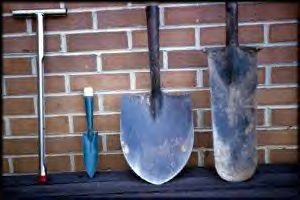
|
| Home | Reading Room | Newsletter | Reminders | Technique | Nursery |
| News | Sustainable Gardening | Trees & Shrubs | Flowers | Composting | Soil |
| Shopping | Tools | Books | How To's | Practical Advice | Children | IPM |
Home
Soil Sampling EquipmentTo collect samples use a stainless steel or chrome-plated soil probe, hand garden trowel, shovel or spade (displayed left to right in the picture below). Do not use brass, bronze, or galvanized tools because they will contaminate samples with copper and/or zinc.
Some of the disadvantages of a soil probe are: it cannot be used when the soil is too wet because the soil compresses; it cannot be used when the soil is too dry because it is difficult to penetrate the soil. Soil probes also do not work well in soils that contain gravel. Soil probes are available through agricultural supply companies or your agriculture Extension agent may be able to help you locate a supplier. Cost is typically $25 or more. Mix soil samples in a clean, plastic bucket. If the bucket has been used to hold fertilizer or other chemicals, wash and rinse it thoroughly before using it for soil samples. Even a small amount of lime or fertilizer transferred from the sampling tools to the soil can seriously contaminate the sample and produce inaccurate results. In addition to these tools, if you plan to submit your sample to a Soil Testing Laboratory, you may need a Soil Sample Information Sheet and a Soil Sample Box. Both are available from your the extension office in your county or city. Look in the government pages of your phone book or extension office for the address and phone number of your local Extension office.
Before we proceed let's check what you have learned about the proper equipment for soil sampling!
|
| Reading Room | Trees and Shrubs | Flowers | Composting | Soil | Nursery |
| Shopping | Books | Tools | News | Internet Gardening | Links | Support |
| Vermicomposting | Pest Management | How To's | Practical Advice | Children |
| Home | Newsletter | About Us | Support | Contact |
|
GardenSimply.com | All Rights Reserved 2005 |
|
FREE
Garden Journal!! Join "Garden Notes" and plan for Harvest
Success as you track and record your gardening progress. Your Free Personal
Garden Journal includes printable pages making it easy for you to:
|
|
|
|
|
|
|
|
|
|

|
|
|
|
 The soil probe is the best tool for collecting soil samples.
The soil probe works better than a shovel or trowel because
this tool equally collects soil in a continuous core from the
surface through the entire sampling depth with minimal disturbance
of the soil. It also allows for faster sampling.
The soil probe is the best tool for collecting soil samples.
The soil probe works better than a shovel or trowel because
this tool equally collects soil in a continuous core from the
surface through the entire sampling depth with minimal disturbance
of the soil. It also allows for faster sampling. 


